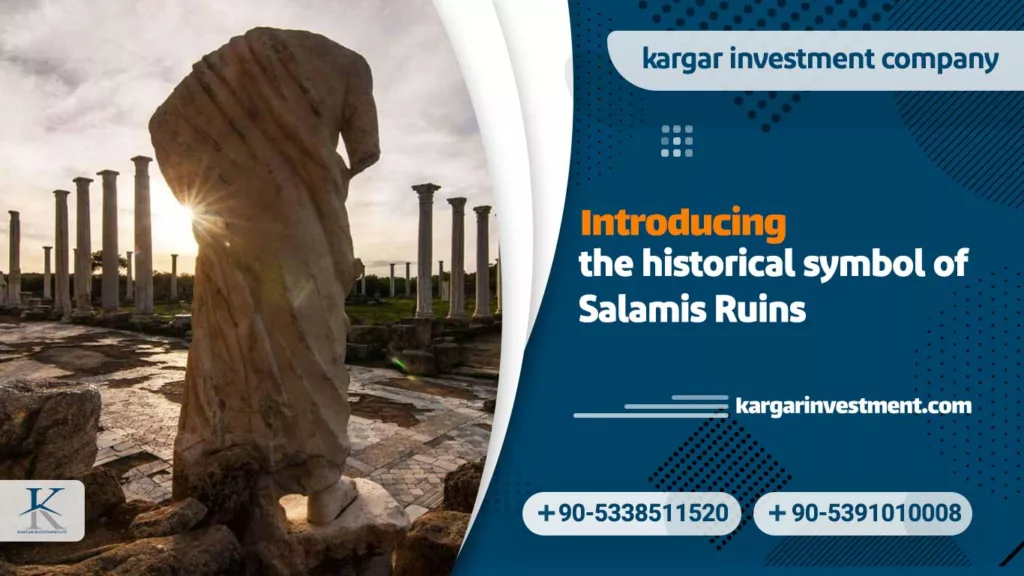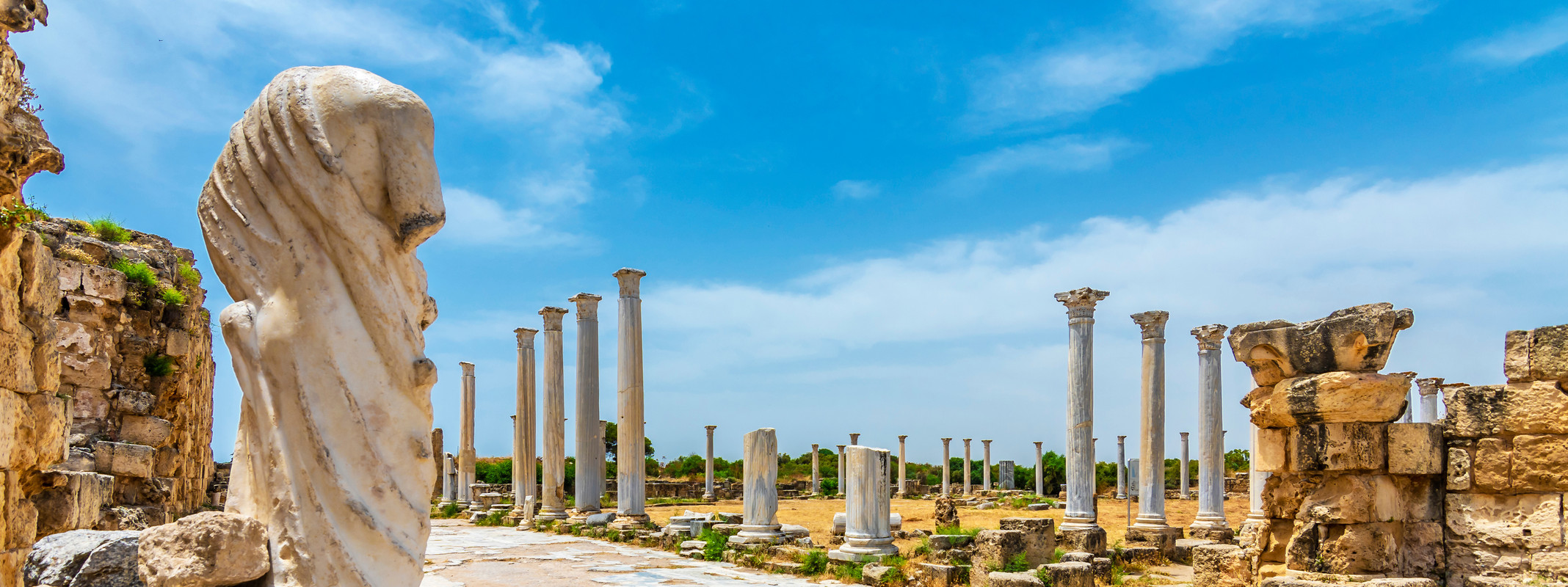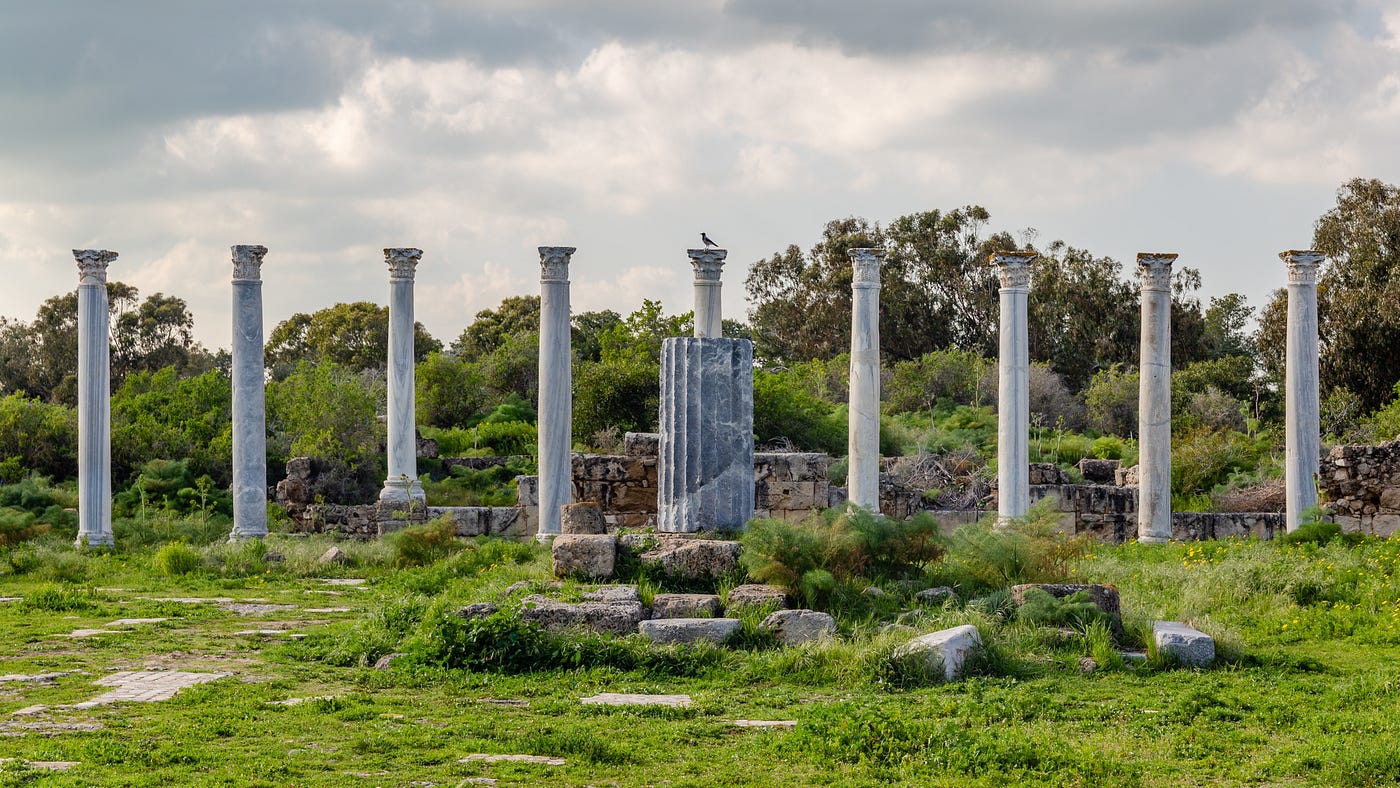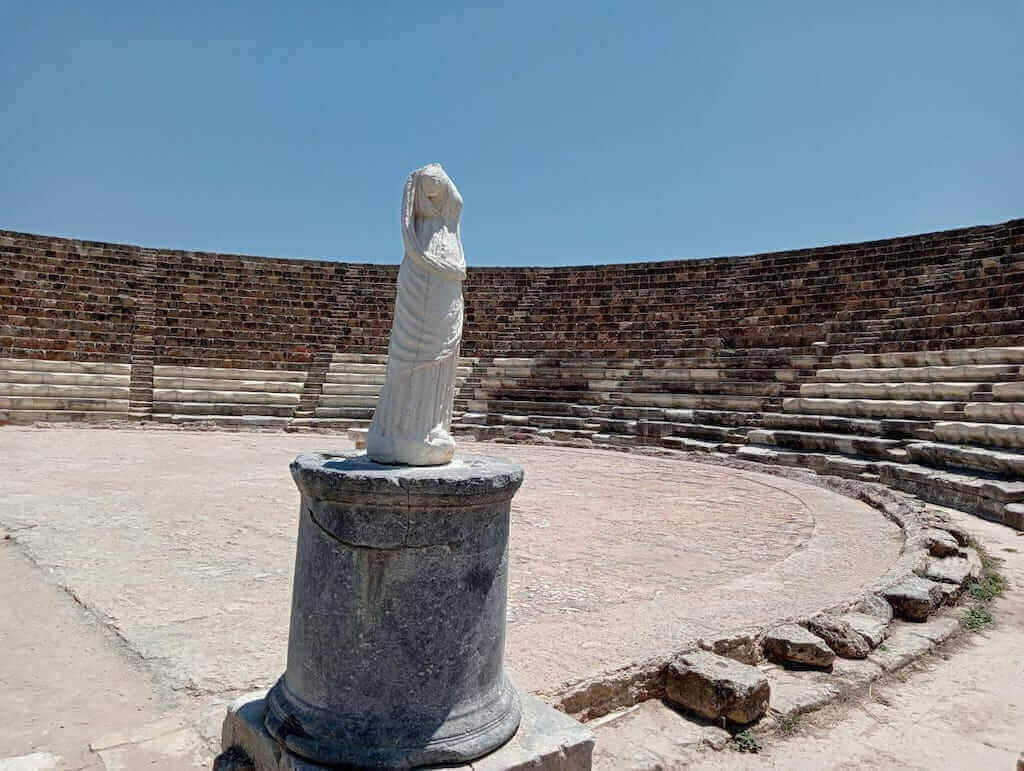Introducing the historical symbol of Salamis Ruins
In a corner of the eastern Mediterranean, somewhere between the azure waves and sunny beaches of Northern Cyprus, a hidden treasure of the glory of ancient empires awaits discovery. This treasure is none other than the “Historical Symbol of Salamis Ruins”, an ancient city that was once the beating heart of the Eastern Mediterranean.
Walking among the ruins of Salamis Ruins will give you the feeling of traveling deep into history. A city that once witnessed important historical events, epic battles and ups and downs of great civilizations. Archaeologists date this city to the 11th century BC. When the Phoenicians, the great seafarers of that era, laid the first stones of this city on the eastern coast of North Cyprus.
Over the centuries, the “Historical Symbol of Salamis Ruins” has witnessed the rule of the Assyrians, Egyptians, Persians, and finally the Greeks and Romans. Every empire has left a bright trace of its culture and architecture on the body of this city. This multiplicity of governments has led to the formation of a rich and unique cultural identity in Salamis Ruins.
Archaeological excavations have so far revealed only parts of this vast city. But these discovered parts show the greatness and glory of this “Historical Symbol of Salamis Ruins” to the world. Archaeologists believe that the size of the city reached about 50 square kilometers during its heyday.
In the continuation of this article, we will step into the depths of history, together to the corners of the “Historical Symbol of Salamis Ruins” and discover the secrets hidden in the heart of these magnificent ruins.
Kargar, a consulting and investment company, with more than 14 years of brilliant experience in the field of investment and property purchase in North Cyprus, is always with you to make the dream of owning a house next to the beautiful Mediterranean beaches a reality. Contact our experienced experts for more information about investment opportunities in North Cyprus and buying property near the “Historical Icon of Salamis Ruins”.
In the previous section, we briefly introduced the “Historical Symbol of Salamis Ruins” and depicted the greatness and glory of this ancient city. In this section, we are going to take a virtual trip to the ruins of this city and get to know some of its most important parts.
The most important parts of the historical symbol of Salamis Ruins
Gymnasium: One of the most important parts of the “Historical Symbol of Salamis Ruins” is its gymnasium. This hall, which was built in the 4th century BC, is considered the largest sports hall in the ancient world. The size of this hall was so large that it could accommodate up to 20,000 spectators.
Agora: The beating heart of every ancient city was the “Agora” or its main square. The “Historical Symbol of Salamis Ruins” is no exception to this rule. The Agora of Salamis was a place of trade, public gatherings and important political events. The remains of this square, including columns, temples and shops, can still be seen.
Theater: Art and drama have a special place in ancient Greek culture. For this reason, in most of the ancient cities of Greece, a theater has been built to perform various shows. The “Historical Symbol of Salamis Ruins” is no exception to this rule. The theater of Salamis, which was built in the second century BC, is considered one of the largest theaters in the ancient world. This theater has a capacity of 15 thousand spectators.
Tombs: There are numerous tombs from different historical eras in the “Salamis Ruins Historical Icon”. These tombs, which are built in different shapes and sizes, represent the beliefs and religious customs of the people of this city during different eras.
Museum: There is a museum in the “Historical Symbol of Salamis Ruins” where the objects and artifacts discovered from this city are exhibited. These objects include statues, pottery, coins and ornaments. Visiting this museum is a great opportunity to learn about the history and culture of the “Historical Icon of Salamis Ruins”.


The most important parts of the historical symbol of Salamis Ruins
The hidden secrets and stories of the “Historical Symbol of Salamis Ruins”
In the previous sections, we introduced the “Historical Symbol of Salamis Ruins” and some of its most important parts. In this section, we intend to travel beyond the history of this ancient city and discover its hidden secrets and fascinating stories.
Theater Legend: According to legends, the first theater performances in the world were staged in the “Historical Icon of Salamis Ruins”. It is said that these shows were held to commemorate the victory of the Greeks over the Persians in the Battle of Salamis.
Temple of Zeus: In the “Historical Icon of Salamis Ruins” there was a magnificent temple named after Zeus, the king of the ancient Greek gods. This temple, which is considered one of the largest temples in the ancient world, was destroyed in an earthquake. But its remains, including its massive columns, can still be seen.
The Salamis Treasure: In 1961, archaeologists while excavating the “Historical Icon of Salamis Ruins” came across a unique hoard of gold coins, jewelry, and silverware. This treasure, known as “Treasure of Salamis”, is considered one of the most important archaeological discoveries in the 20th century.
Love stories: “The historical symbol of Salamis Ruins” has been the scene of many love stories. One of the most famous of these stories is the love story of “Pyrmus” and “Tisbeh”. These two lovers, who were from hostile families, met each other secretly. But finally their secret was revealed and both of them were sentenced to death.
See more: Life in Northern Cyprus
last word
“Historical symbol of Salamis Ruins” is not only a collection of ancient ruins, but a window to the depths of history and brilliant civilizations of the past. Touring among these magnificent ruins will make a memorable trip for you and will give you an exceptional opportunity to learn about the culture, art and architecture of ancient Greece.
In this article, we tried to depict a corner of the greatness and glory of the “Historical Symbol of Salamis Ruins” and introduce you to some of the most important parts of this ancient city.
But the story of the “Historical Symbol of Salamis Ruins” does not end here. There are still many untold secrets and stories hidden in the heart of these ancient ruins that explorers and archaeologists are trying to discover.
If you are looking for a unique and memorable trip, put the “Historical Symbol of Salamis Ruins” on your list of tourist destinations.
Kargar, your companion on the trip to Northern Cyprus
Kargar, the consulting and investment company, with more than 14 years of brilliant experience in the field of property purchase and investment in North Cyprus, is proud to be by your side to make your dream of owning a home next to the beautiful Mediterranean beaches a reality.
Frequently asked questions about the historical symbol of Salamis Ruins
- Where is the “Historical Symbol of Salamis Ruins” located?
This ancient city is located in northern Cyprus, on the east coast of this island.
- When does the “Historical Symbol of Salamis Ruins” date back?
Archaeologists date this city to the 11th century BC.
- What empires have ruled over the “Historical Icon of Salamis Ruins” throughout history?
The Phoenicians, Asyrians, Egyptians, Persians, Greeks and Romans are among the empires that ruled this ancient city in different periods.
- What are the most important parts of the “Historical Icon of Salamis Ruins”?
Sports hall, agora, theater, tombs and museum are among the most important parts of this ancient city.
- What makes the “Historical Symbol of Salamis Ruins” a unique tourist destination?
This ancient city is a window to the depths of history and brilliant civilizations of the past. Touring among these magnificent ruins will make a memorable trip for you and give you an exceptional opportunity to learn about the culture, art and architecture of ancient Greece.
- How to visit the “Historical Icon of Salamis Ruins”?
You can visit this ancient city independently or by participating in tourist tours.
- Is it possible to stay near the “Historic Symbol of Salamis Ruins”?
Yes, there are various hotels and accommodations near this ancient city.
- When is the best time to visit the “Historical Icon of Salamis Ruins”?
The best time to visit this ancient city is spring and autumn, when the weather is mild and sunny.
- Is a visa required to visit the “Historical Symbol of Salamis Ruins”?
Yes, you need a visa to travel to Northern Cyprus.











